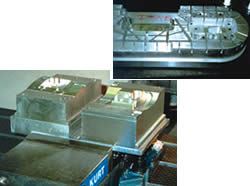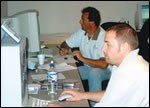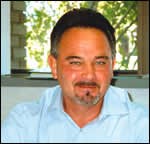Speeding To Success
Using a company-wide mantra of faster, faster, faster, some innovative processing techniques and a rationalized deployment of personnel, this Detroit mold maker is snatching success from the jaws of competition.
Share




It was about 3 years ago that Bob Mandeville, president of Elite Mold & Engineering (Sterling Heights, Michigan) saw the handwriting on the wall. Business was good then but the question was—how long would it stay good?
Mr. Mandeville seized on the idea of reducing the time required for his shop to process a customer order. “Work faster, or be gone,” sums up Mr. Mandeville’s thinking at the time. “There wasn’t a great deal of pressure 3 years ago from our customers, it just seemed to me that pro-activity on our part would put us in a better competitive position should the business turn down.” Well, turn down turned out to be an understatement. A large portion of moldmaking business turned east . . . Far East.
Elite has managed to stay busy and profitable throughout the migration of recent years, and it continues to evolve a strategy based on getting good molds made quickly. “The idea,” says Mr. Mandeville, “is to exceed customer expectations. The trick is finding ways to continuously improve our ability to exceed expectations that continuously become higher.”
A Nice Niche
Elite concentrates most of its energy on producing prototype molds that fit within a 500 ton or less molding range. It serves a variety of industries including automotive, appliance and marine. Most of the mold work that the shop produces falls in the 30-inch by 40-inch size range.
Aluminum is the material of choice for these mold sets. Elite can and does manufacture production molds from tool steel, but increasingly its prototype niche is where the shop competes best.
The shop is full service, providing its customers with design, build and qualified mold sets. Three injection molding machines are available on the shop floor to produce prototype sample parts and qualify the production molds before shipping. An additional 17 molding machines are also available at a sister company, Elite Plastic Products, for 120 ton to 400 ton production range.
“When a design engineer sends us a CAD file,” says Mr. Mandeville, “we are going to be much appreciated by the engineer if we can help him get parts in 1 week rather than 6 weeks. That 6 to 1 ratio represents the reduction in delivery time we have been able to implement in the past 3 years.”
Selecting The Right Work
Reducing the time to manufacture prototype mold sets from weeks to days is the strategic goal of Elite. Making this happen on the shop floor is, of course, complex.
In the tactical trenches, the process begins with the selection of the work that can fit Elite’s strategic plan. No shop wants to pass on work but, at the same time, no shop can long afford to lose money on jobs or fall short of its commitments
“Taking a page from our injection molding shop strategy,” says Mr. Mandeville, “we lowered our machine shop cost/hour rate, which allowed us an 80 percent utilization rate by running the machines 24/7 with unattended shifts.”
To achieve this, Elite is selective about its work. “I look for jobs that can be processed with a ratio of 70 percent machining to 30 percent labor,” says Mr. Mandeville. “That’s a total figure and includes programming, machining, and fit and finish.”
Eliminating Bottlenecks
When Elite began its time reduction program, one large bottleneck emerged immediately. “The balancing of our programming time and machining time were out of sync,” recalls Mr. Mandeville. “Some of the issues were with the programmers, and others centered on the software and computers we were using. We standardized on Mastercam software for all of our programmers and placed a standing purchase order with our computer supplier. When a faster computer comes out, we buy it. Elite generally upgrades all its programming hardware and software twice a year.”
To help programmers become better faster, the structure of the programming department was realigned to a more team-based approach. Standardization of the programming tools naturally led to more interaction between the programmers who relish telling their colleagues about new shortcuts or clever solutions. For the shop, these changes have accelerated the programming turnaround and brought programming and machining times into better balance.
Outside the shop, training of Elite’s suppliers was also made a priority. “We don’t inventory raw stock in the shop,” says Mr. Mandeville. So when Elite orders aluminum stock from it supplier and specifies same day delivery, it really means same day. “It took some time before they understood,” he adds. “It’s working out fine now.”
Creative Processing
To expedite work through the shop, Elite uses some interesting processing techniques. Raw stock, for example, is purchased in 12 foot lengths with sufficient width and depth for its range of mold work. The stock is cut to length allowing several jobs to be made from a single billet. To save pre-process time, raw materials are placed on the machining centers and milled square and to overall size as part of the machining program.
The Fadal machining centers are capable of 10,000 rpm, and Elite uses this to its fullest. “We run these machines as close to full speed as possible, 24/7,” says Mr. Mandeville. “High speed machining has helped reduce the cycle time for the mold cores and cavities and still produce tolerances of 0.0002 inch.”
Increasingly, the shop is using milling as a replacement for EDM and some assembly. High speed milled surface finishes coming off the VMCs are excellent and have allowed Elite to reduce benching and spotting to 10 percent of the job cost.
On some of the molds, ribs are now machined instead using EDM. “We’ve been able to successfully mill ribs up to 3 inches deep and only 0.080 inch wide,” says Mr. Mandeville. The shop has EDM capability but uses it as sparingly as possible to expedite delivery.
Another technique the machining centers allow the shop to use is cutting cores and cavities from a single aluminum block. A raw aluminum block is sawed from the 12-foot billet. This block is mounted in a vise on the machining center. The program is set up so both the core and cavity are cut from this single block and, as the last operation, milled into two pieces. “What’s amazing,” says Mr. Mandeville, “is the two halves fit perfectly right off the machine. It’s a very efficient process for our shop.”
Another milling technique Elite uses to reduce assembly is to mill locating pins into the mold bases, when feasible. At high speed and feed, it is often more economical to machine the mold set as complete as possible including the pins.
Using Obsolescence As Strategy
A large piece of Elite’s strategy is keeping the shop technologically current. For example, the VMCs Mr. Mandeville purchased new 3 years ago are less capable than the machines he installed 6 months ago. “It’s a natural progression,” he says. “Technology providers, whether they are developing software or hardware for manufacturers, must continuously improve the products they bring to market. These incremental advances play out as productivity enhancers and allow us to increase throughput and reduce turn around time. In my shop, we need to be able to afford to purchase new technology to be competitive and stay ahead of our customers’ expectations.”
Accepting technology obsolescence as a fact and capitalizing on it is an important consideration for Elite and other shops as they move forward in an increasingly competitive marketplace. Giving good employees the best tools available is an incentive that pays off in the longer run. Capital expenditure justification plateaus are getting lower as metalworking is pressured to eek out nickels, dimes and quarters from their products and services.
“Reducing our cost of manufacturing through a continuous productivity improvement is how we choose to compete,” says Mr. Mandeville. “In our niche, rapid delivery of prototype molds is how we differentiate our shop.”
Related Content
Tsugami Lathe, Vertical Machining Center Boost Machining Efficiency
IMTS 2024: Tsugami America showcases a multifunction sliding headstock lathe with a B-axis tool spindle, as well as a universal vertical machining center for rapid facing, drilling and tapping.
Read MoreDN Solutions America Unveils Impressive Chicago Technical Center at IMTS 2024
New tech center is serving as a cutting-edge showroom and a technological hub for advanced machining applications.
Read MoreIn Moldmaking, Mantle Process Addresses Lead Time and Talent Pool
A new process delivered through what looks like a standard machining center promises to streamline machining of injection mold cores and cavities and even answer the declining availability of toolmakers.
Read MoreHow a Custom ERP System Drives Automation in Large-Format Machining
Part of Major Tool’s 52,000 square-foot building expansion includes the installation of this new Waldrich Coburg Taurus 30 vertical machining center.
Read MoreRead Next
Building Out a Foundation for Student Machinists
Autodesk and Haas have teamed up to produce an introductory course for students that covers the basics of CAD, CAM and CNC while providing them with a portfolio part.
Read MoreSetting Up the Building Blocks for a Digital Factory
Woodward Inc. spent over a year developing an API to connect machines to its digital factory. Caron Engineering’s MiConnect has cut most of this process while also granting the shop greater access to machine information.
Read More5 Rules of Thumb for Buying CNC Machine Tools
Use these tips to carefully plan your machine tool purchases and to avoid regretting your decision later.
Read More



































